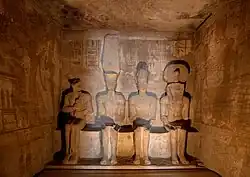List of pharaohs deified during lifetime

| Part of a series on |
| Ancient Egyptian religion |
|---|
 |
|
|
In ancient Egypt, it was standard for pharaohs to be worshipped posthumously as transfigured beings amongst the royal ancestors. This was generally performed in the form of a mortuary cult.[1][2] During the pharaoh's lifetime, they were generally recognized as having divine properties, in accordance with imperial cult government. However, it was exceedingly rare for a pharaoh to have a cultic devotion of worshippers during the pharaoh's lifetime. Such followers regarded the pharaoh’s divine status as equivalent to that of a true deity, though only a few pharaohs were honored with formal cult worship. This was usually as a result of successful self-deification attempts typically substantiated by military accomplishment or political leadership.
Pharaohs deified during their lifetime
A few pharaohs have been confirmed to have been honored with cultic worship as deities during their lifetime. Ptolemaic pharaohs were also deified during their lifetime, although the theological context is different from that of the pharaonic era deifications. In Pharaonic Egypt, for a pharaoh to have a cultic devotion during their lifetime was a form of honorific exaltation. Egyptologist Karen Byrson writes:[3]
"Any king could expect to be venerated among the royal ancestors and as a transfigured being after death. Some, however, became the object of more intense and specialized worship in life"
This deification is analogous to how for ancient Egyptian nonroyals, to be posthumously deified was a form of honorific exaltation, as nonroyals were generally not posthumously deified.
| Pharaoh | Dynasty | Reigned | Deification | Spouse deified | |||
|---|---|---|---|---|---|---|---|
| Pharaonic Egypt[4][5][6] | |||||||
| Senusret III was deified during his lifetime as a god in his own right, due to his military achievements. He was traditionally likened to the warrior goddess Sekhmet.[8][9] | No
| ||||||
Amenhotep III initiated his own self-deification[11] towards the end of his lifetime as the dazzling Aten.[12] He was not a warrior pharaoh, known to only have participated one military campaign. Instead of establishing his divinity by military prowess, he grounded his self-deification in political leadership, as ancient Egypt reached reached its peak splendor during his reign.[13] Egyptologists David O'Connor and Eric H. Cline have examined the relationship between Amenhotep III's cult and Akhenaten's Atenism, concluding that the influence of the former on the latter is unquestionable. Further, they argue that the former laid the religiopolitical and theological foundations for the latter, proposing:
Amenhotep III concurrently deified his wife, Queen Tiye,[15] who was associated with the goddess Hathor.[16] |
Yes
| ||||||
A cult devoted to the deified form of Tutankhamun as the incarnation of the god Amun developed after the religiopolitical countermand away from Atenism.[18] Military achievement, especially in the event that Tutankhamun was battle participatory, substantiated the deification. Egyptologists Colleen Manassa and John Darnell write of Tutankhamun's military robustness in Nubia:
Also, the Stela of Huy equates Tutankhamun with the god Amun. |
No
| ||||||
| Ramesses II deified himself during his lifetime[21] as the god Amun, his favorite god,[22] while retaining his own personal identity,[23] primarily for his military campaigns and diplomatic successes.[24] For example, Stele Aksha 505 describes how Ramesses II's status in the army was divine.[25] He concurrently deified his wife Queen Nefertari.[26] | Yes
| ||||||
| Ptolemaic Kingdom[27] | |||||||
| Ptolemaic rulers | The Ptolemaic Dynasty had its own distinct imperial cult theologically founded upon Alexander the Great, who was posthumously deified. As the Ptolemaic Dynasty progressed, its dynastic cult eventually led to the rulers' self-deification and worship as deities during the rulers' lifetime. In this dynastic cult, it was generally standardized for couples to be co-deified during their lifetime. Historian Tara L. Sewell-Lasater stated :
The tradition continued through to the famous ruler Cleopatra, who herself was a descendant of Ptolemy I. It lasted until the end of the reign of the Ptolemaic dynasty's last sovereign ruler Ptolemy XV Caesar. |
Yes
(standard) | |||||
In overview, aside from Senusret III, all confirmed cultic devotion to deified forms of indigenous ancient Egyptian pharaohs occurred within relative chronological proximity to each other. Similarities of those cults has been noted by scholars. Egyptologist Lanny Bell wrote that:[18]
"It is known that both Tutankhamun and Ramesses II patterned their own cults after Amenhotep III in Nubia"
However, a key difference between the cult of Amenhotep III and the Tutankhamun and Ramesses II cults is that Amenhotep III strictly substantiated his cult on political leadership as opposed to military performance. Also, the deification of Ramesses II did not equate himself with Amun, unlike in Tutankhamun's deification, but rather identified Ramesses II as a distinct person in Amun's likeness. Another point to note is that only Senusret III's and Tutankhamun's cults have no evidence of co-deification of their respective spouses, while Amenhotep III's cult, Ramesses II's, and the Ptolemaic cults did.
All four cults had established worship occurring at Nubia, not just in Egypt.
Also, notably, there is not evidence that Thutmose III, Egypt's most militarily successful pharaoh, was deified during his lifetime.
Pharaohs possibly deified during their lifetimes
There is some evidence or speculation that other pharaohs were deified during their lifetimes.
| Pharaoh | Dynasty | Reigned | Deification | ||||
|---|---|---|---|---|---|---|---|
| Pharaonic Egypt | |||||||
| It has been stipulated that Mentuhotep II was deified during his lifetime, but this is disputed.[29] | |||||||
| Akhenaten attempted to deify himself during his Atenism religiopolitical upheaval, although the success of this attempt has not been conferred.[30] | |||||||
| There is some evidence that Horemheb had a cult devotion during his lifetime,[32] although this is disputed.[33] | |||||||
Because deification during a pharaoh's lifetime increases a leader's power within their religious circle, it was a sought-after. Various pharaohs attempted self-deification during their lifetime, but not every attempt was successful.
See also
- List of people who have been considered deities
- Apotheosis
- Cult of personality
- Culture hero
- Euhemerism
- Folk saint
- God complex
- Hero cult
- Idolatry
- List of deities
- List of demigods
- Sacred king
- Veneration of the dead
- Theocracy
- Amenhotep, son of Hapu
- Ahmose-Nefertari
- Heqaib
- Djedefhor
- Ptahhotep
- Kagemni I
- Mount Rushmore
Further reading
- Bell, Lanny (1985). Aspects of the Cult of the Deified Tutankhamun.
- Habachi, L. (1969). Features of the Deification of Ramesses 2. Abhandlungen des Deutschen Archaologischen Instituts Kairo. Agyptologisches Reihe. J.J. Augustin. Retrieved 18 August 2025.
References
- ^ Bommas, Martin; Harrisson, Juliette; Roy, Phoebe (6 December 2012). Memory and Urban Religion in the Ancient World. London New Delhi New York Sydney: A&C Black. ISBN 978-1-4411-3014-3.
- ^ Meskell, Lynn (2001). "The Egyptian Ways of Death". Archaeological Papers of the American Anthropological Association. 10 (1): 27–40. doi:10.1525/ap3a.2001.10.1.27. ISSN 1551-823X.
- ^ Bryson, Karen (Maggie) (16 November 2018). ""Man, King, God? The Deification of Horemheb"". Academia.edu. Retrieved 6 January 2025.
- ^ Charlton, Nial (1974). "Some Reflections on the History of Pharaonic Egypt". The Journal of Egyptian Archaeology. 60: 200–205. doi:10.2307/3856187. JSTOR 3856187. Retrieved 4 June 2025.
- ^ Shaw, Ian (6 May 2015). "Pharaonic Egypt". Academia.edu. Retrieved 4 June 2025.
- ^ Bruins, Hendrik J. (18 June 2010). "Dating Pharaonic Egypt". Science. 328 (5985): 1489–1490. doi:10.1126/science.1191410. ISSN 0036-8075. Retrieved 4 June 2025.
- ^ "The Oxford Guide: Essential Guide to Egyptian Mythology", Edited by Donald B. Redford, p. 85, Berkley, 2003, ISBN 0-425-19096-X
- ^ "Hymns to king Senusret III". UCL. Retrieved 23 May 2025.
- ^ Lloyd, Alan B., ed. (2014). A companion to ancient Egypt. Blackwell Companions to the Ancient World (Paperback ed.). Malden, Mass.: Wiley Blackwell. ISBN 978-1-118-78514-0.
- ^ Kozloff, Arielle P. (20 February 2012). Amenhotep III. Cambridge; New York: Cambridge University Press. pp. 2, 51, 121, 174, 197. ISBN 978-1-107-01196-0.
- ^ Laboury, Dimitri (2017). "Senwosret III and the Issue of Portraiture in Ancient Egyptian Art". Cahier de Recherches de l'Institut de Papyrologie et d'Égyptologie de Lille. Université de Lille, Lille, France: 77. hdl:2268/223728. ISSN 0153-5021. Retrieved 9 January 2025.
- ^ Tutankhamun: discovering the forgotten Pharaoh: exhibition organized at the Europa expo space TGV train station "les Guillemins", Liège, 14th December 2019-30th August 2020. Liège: Presses universitaires de Liège. 2020. p. 239. ISBN 978-2-87562-245-7.
- ^ Phelps, Danielle O. (2020). "Intentionally Forgetting: An Anthropological Examination of the Burial of Tutankhamun in the Valley of the Kings, Egypt". The University of Arizona. p. 65-66. Retrieved 18 July 2025.
- ^ O'Connor, David B.; Cline, Eric H. (2001). Amenhotep III. Ann Arbor: University of Michigan Press. p. 91. ISBN 0-472-08833-5.
- ^ "Queen Tiye and her Family". ProQuest. 1 January 2000. ProQuest 1293472880. Retrieved 6 January 2025.
- ^ Budin, Stephanie Lynn; Turfa, Jean MacIntosh (2016). Women in antiquity: real women across the ancient world. London New York: Routledge, Taylor & Francis Group. ISBN 978-1-315-62142-5.
- ^ Press, Oxford University (2003). The Oxford Essential Guide to Egyptian Mythology. Berkley Books. p. 85. ISBN 978-0-425-19096-8.
- ^ a b Bell, L. (1985). Aspects of the Cult of the Deified Tutankhamun.
- ^ Darnell, John Coleman; Manassa, Colleen (3 August 2007). Tutankhamun's Armies. Hoboken, N.J.: John Wiley & Sons. p. 135. ISBN 0-471-74358-5.
- ^ a b Lichtheim, Miriam (1973). "Features of the Deification of Ramesses II . Labib Habachi". Journal of Near Eastern Studies. 32 (3): 354–355. doi:10.1086/372293. ISSN 0022-2968.
- ^ Price, Campbell (1 January 2011). "'Ramesses, "King of Kings": On the Context and Interpretation of Royal Colossi'". S. Snape and M. Collier (Eds) Ramesside Studies in Honour of K. A. Kitchen (Rutherford Press, Bolton, 2011), 403-411.: 404. Retrieved 13 January 2025.
- ^ Treasure, Matthew (1 January 2021). "Four Faces on One Neck: The Tetracephalic Ram as an Iconographic Form in New Kingdom Egypt". Academia.edu. Retrieved 13 January 2025.
- ^ Eyma, A. K.; Bennett, C. J. (2003). A Delta-man in Yebu. S.l.: Universal-Publishers. ISBN 1-58112-564-X.
- ^ Furlan, Urška; Husøy, Thomas Alexander; Bohun, Henry (30 September 2022). Narratives of Power in the Ancient World. Newcastle-upon-Tyne: Cambridge Scholars Publishing. p. 64. ISBN 978-1-5275-8276-7.
- ^ A. Rosenvasser, "The Stele Aksha 505 and the Cult of Ramesses II as a God in the Army", RIHAO 1 (1972), p. 104
- ^ Xekalaki, Zeta (28 September 2011). "Aspects of the Cultic Role of Queen Nefertari and the Royal Children during the Reign of Ramesses II". Academia.edu. Retrieved 13 January 2025.
- ^ Hölbl, Günther (2001). A History of the Ptolemaic Empire. Hoboken: Psychology Press. ISBN 0-415-23489-1.
- ^ Sewell-Lasater, Tara (1 January 2020). "Becoming Kleopatra: Ptolemaic Royal Marriage, Incest, and the Path to Female Rule". University of Houston Dissertation Repository: 92. Retrieved 5 June 2025.
- ^ Karwowska, Paulina (2023). "In the presence of my king forever: Royal images in the tombs of noblemen of the Middle Kingdom and beyond". Polish Archaeology in the Mediterranean. 32 (2): 160. doi:10.37343/uw.2083-537X.pam32.2.08. ISSN 2083-537X.
- ^ Wade, Sabrina (1 October 2021). "Atenism and Pharaoh Akhenaten's Attempt to Deify Himself". Armstrong Undergraduate Journal of History. 11 (2). doi:10.20429/aujh.2021.110201. ISSN 2163-8551. Retrieved 6 January 2025.
- ^ Martin, Geoffrey Thorndike (1989). The Memphite Tomb of Ḥoremḥeb, Commander-in-chief of Tutʻankhamūn: Human skeletal remains. London: Egypt Exploration Society. pp. 72, 73. ISBN 978-0-85698-188-3.
- ^ "www.aegyptologie.com" (PDF).
- ^ Bryson, Karen M (13 April 2018). "The Reign of Horemheb: History, Historiography, and the Dawn of the Ramesside Era". JScholarship. Retrieved 6 January 2025.
